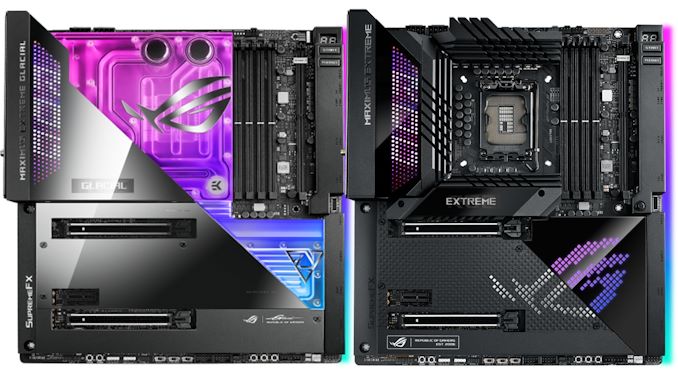The Intel Z690 Motherboard Overview (DDR5): Over 50+ New Models
by Gavin Bonshor on November 9, 2021 9:00 AM ESTASUS ROG Maximus Z690 Extreme Glacial & Z690 Extreme (DDR5)
Starting off the ASUS Z690 product stack with support for the latest DDR5 memory, we have an equally impressive pair of flagships for users to sink their teeth into. It should be noted for Z690, ASUS has tweaked its naming scheme for its Maximus branded board. Typically in the past, it has used roman numerals to depict the series, but in the interests of making it simple for users to digest, it now opts to use the specific chipset name instead; hooray for simplicity.
The first of the aforementioned flagships is the latest Extreme motherboard from ASUS, specifically the ASUS ROG Maximus Z690 Extreme Glacial. It shares the same feature and controller set as the regular ROG Maximus Z690 Extreme model, but with one major difference, The Extreme Glacial has a brand new custom 'Ultrablock' designed and manufactured by premium water cooling experts EKWB, which includes plenty of integrated RGB LED lighting and looks very premium indeed. Both include dot matrix displays built into the rear panel over, while the non-water block clad ROG Maximus Z690 Extreme model, it includes a dot matrix panel covering the chipset heatsink too.

The ASUS ROG Maximus Z690 Extreme Glacial (left) and Z690 Extreme (right) motherboards
Both the ASUS ROG Maximus Z690 Extreme Glacial and ROG Maximus Z690 Extreme share the same feature and controller set, with both featuring two full-length PCIe 5.0 slots operating at x16 or x8/x8, with a smaller PCIe 3.0 x1 slot. In the top right-hand corner of both models are four memory slots with support for up to DDR5-6400, with a maximum supported capacity of up to 128 GB. Also in the top right-hand corner is a DIMM.2 slot, with combined total support for up to five M.2 drives, including one PCIe 5.0 x4 M.2 and four PCIe 4.0 x4 M.2 drives, with six SATA ports supporting RAID 0, 1, 5, and 10 arrays.
On the rear panel of both models is lots of premium connectivity, including one Thunderbolt 4 Type-C, one USB 3.2 G2x2 Type-C, and eight USB 3.2 G2 Type-A ports. ASUS does include an HDMI video output for users, as well as a Marvel AQtion 10 GbE controller, with a secondary RJ45 port powered by an Intel I225-V 2.5 GbE controller. Wireless capabilities are provided by an unspecified Intel Wi-Fi 6E CNVi, which also supports BT 5.2 devices. For onboard audio, five 3.5 mm audio jacks and S/PDIF optical output are powered by a Supreme FX4082 HD audio codec and ESS Sabre 9018Q2C DAC pairing, while ASUS also includes a BIOS Flashback button and clear CMOS button.










126 Comments
View All Comments
Dahak - Tuesday, November 9, 2021 - link
Will there be a list of DDR4 only board as well?Ryan Smith - Wednesday, November 10, 2021 - link
Yes, we're also putting together a guide for DDR4 boards.jh20001 - Wednesday, December 1, 2021 - link
Any news on the DDR4 story? Would be nice to know what model is the best for performance/features in the eyes of others.Flunk - Tuesday, November 9, 2021 - link
Intel's actually released a compelling new chipset? I'm surprised to see DDR5 and PCIe 5 support, but USB 4 seems to be notably absent, despite there being no reason at all to omit it. Intel is finally one-upping AMD after a few years of playing #2.Exotica - Tuesday, November 9, 2021 - link
Thunderbolt4 is usb4 capable…CharonPDX - Tuesday, November 9, 2021 - link
Yep, the only thing USB4 adds over "USB 3.2 2x2" is Thunderbolt support. Therefore any Thunderbolt 4 device is automatically USB4. In fact, essentially any board with "Thunderbolt 3" along with USB 3.2 2x2 basically get "USB4" status for free.DigitalFreak - Tuesday, November 9, 2021 - link
USB 3.2 2x2 is 20 Gbps. USB 4 is 40 Gbps.12345 - Wednesday, November 10, 2021 - link
That's why they mentioned TB3. 40Gbps support is also optional for USB4.12345 - Wednesday, November 10, 2021 - link
DP 2.0 is mandatory for USB4 so TB3 support isn't good enough.KarlKastor - Wednesday, November 10, 2021 - link
That is only the name. The question is, with what speed you can run USB devices.